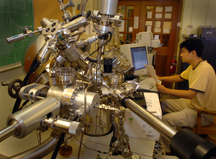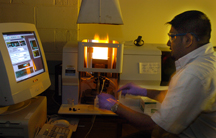
| RELATED INFO |
| • Purdue School of Chemical Engineering |
October 22, 2004
Purdue completes new chemical engineering addition
WEST LAFAYETTE, Ind. – Purdue University today (Friday, Oct. 22) dedicated a new chemical engineering addition that houses advanced laboratories and amphitheater-style classrooms, providing ultra-modern facilities for students and faculty researchers.

|
The 96,000-square-foot, $19.5 million facility was paid for entirely with private donations, including $10 million from Robert and Marilyn Glenn Forney, of Unionville, Pa., both of whom are 1947 chemical engineering Purdue alumni, and $2 million from the Dow Chemical Co. Foundation. The addition is the first educational and research facility in engineering to be built with funds received entirely from private sources.
The addition doubles the size of the Forney Hall of Chemical Engineering, located on the north side of the Purdue Mall. Students and faculty will begin using the addition in January.
"This modern addition is further proof that Purdue means business when it comes to giving faculty and students the very best facilities in which to learn and conduct research," said Purdue President Martin C. Jischke. "Purdue is working hard to remain one of the nation's premier research and teaching institutions, and the support of benefactors like the Forneys is crucial to that effort. We are very grateful to them"
The five-story addition to the university's chemical engineering building has taken about two years to complete.

|
Linda P.B. Katehi, the John A. Edwardson Dean of the College of Engineering, said modern laboratories and classrooms in the new space will help Purdue attract the best students and faculty.
"A major focus is on improving the quality of education and providing the most modern research labs for our faculty," Katehi said. "We'll now be able to give our chemical engineering students certain lab experiences that we weren't able to give them before."
Robert Forney, who worked his entire professional career in the chemical industry, said modern facilities are critical to properly prepare students for fields in chemical engineering.
"It's very gratifying to see the fruition of our gift to Purdue," he said. "We know many future chemical engineers will go on to do great things after passing through these classrooms and labs."
Robert Forney, who holds bachelor's and doctoral degrees from Purdue, as well as an honorary doctoral degree, retired in 1989 as executive vice president of E.I. du Pont de Nemours and Co. Marilyn Glenn Forney, who also earned a bachelor's degree from Purdue, has spent more than 20 years offering expertise in the construction of more than 850 housing units for the low-income elderly and disabled in Delaware and Pennsylvania. She also has led fund-raising efforts in a number of volunteer organizations.
The addition will include modern laboratories for undergraduate and graduate students. A new fundamentals lab will make it possible for undergraduates to conduct engineering experiments and reinforce theory. This lab will enable students to gain experience supporting what they learn as sophomores and juniors so that those studies won't be purely theoretical.
The lab also will give students more experience working in teams, as is common in industry. The students will conduct laboratory projects involving three people to manage the work, collect data, write reports and present what they discovered.
Another new teaching facility, called the advanced lab, is for seniors and first-year graduate students, who will use the facility to learn how to design experiments. The addition also has two research floors. The top floor is for research that includes work to design new chemical catalysts, and the first floor houses labs in bioengineering research.
"Forney Hall will be a teaching and research facility for the future," said School of Chemical Engineering Head Arvind Varma, the R. Games Slayter Distinguished Professor of Chemical Engineering. "New energy sources will need to be discovered. New materials and devices, such as chemical and biological sensors, portable fuel cells and novel and cheaper catalysts, will need to be developed. Growing environmental concerns are making researchers aware of the long-term and global implications of our manufacturing practices.
"All these changes in our profession and our world necessitate new avenues of instruction and research, as well as new investments in world-class facilities. The fundamentals and advanced laboratories in Forney Hall, along with the modern classrooms and research facilities, will permit us to provide the highest quality education for students who will become leaders in industry, academia and society."
The new laboratory facilities will help researchers involved in a new catalyst center funded by the U.S. Department of Energy. The facilities also will be used for research in the growing area of bioengineering, which includes work to create polymers from renewable resources, such as agricultural wastes, and to make pharmaceuticals from plants and microorganisms. The work promises to reduce the nation's dependence on fossil fuels and cut down on carbon dioxide emissions.
"We will be able to explore expanding fields of biotechnology, molecular modeling, catalyst design, energy, pharmaceutical engineering and nanotechnology," Varma said.
The addition contains three amphitheater-style, "interactive" classrooms, one capable of seating 200 students and the other two having 60-seat capacity.
The three new classrooms double the amount of space available per student. The 200-seat classroom, which is about 5,000 square feet, is named in honor of Dow, one of the top three employers of Purdue chemical engineering graduates. The classroom will allow students to participate in a variety of interactive class activities, using multimedia and videoconferencing technologies. The seating is tiered, and worktables are positioned in front of the students.
"Many of our older classrooms are long, with the lecturer sitting up front and some students way in the back," said G.V. Reklaitis, the Edward W. Comings Professor of Chemical Engineering and former head of the school. "The new classrooms are the other way around. They are wider and curved so that the instructor is the focal point.
"This configuration and additional space gives students a modern classroom environment in which they have a table for using laptops and other devices."
The new 60-seat rooms are roughly 1,500 square feet. By comparison, an older chemical engineering classroom that seats 150 students is 1,500 square feet, and a 55-seat room is about half that size.
"In the old lecture hall you couldn't really have students do problem solving or computing in class where they are using software on their laptops, because all they really had was one of those little armchairs, and everyone was sitting crowded together," Reklaitis said.
The school has added seven faculty members since the 2002-2003 academic year, in keeping with the university's strategic plan to expand the number of faculty, reduce the student-to-faculty ratio, increase emphasis on research and graduate programs, and raise the quality of graduate programs.
The chemical engineering addition is part of a campaign by the College of Engineering that will expand overall engineering research and teaching facilities by 60 percent. The College of Engineering's master plan calls for $267 million in new construction, $81 million in new equipment and $60 million in renovations to meet anticipated needs for the next 15 to 20 years. Purdue's engineering program, with 13 academic programs and nearly 6,200 undergraduate students, is one of the largest in the nation. The School of Chemical Engineering enrolls about 120 graduate and 400 undergraduate students.
The dedication is part of a 10-day celebration that focuses on ways Purdue is improving education and helping the state of Indiana as part of the university's strategic plan and $1.3 billion fund-raising campaign.
Writer: Emil Venere, (765) 494-4709, venere@purdue.edu
Sources: Martin C. Jischke, (765) 494-9708
Linda P.B. Katehi, (765) 494-5346, katehi@purdue.edu
Arvind Varma, (765) 494-4075, avarma@purdue.edu
G.V. Reklaitis, (765) 494-4075, reklaiti@ecn.purdue.edu
Rita Hillman, administrative assistant to Arvind Varma, (765) 494-4075, rhillman@purdue.edu
Purdue News Service: (765) 494-2096; purduenews@purdue.edu
Note to Journalists: A video of researchers working in chemical engineering labs related to the new addition is available by contacting Jesica Webb, (765) 494-2079, jwebb@purdue.edu.
PHOTO CAPTION:
Nan Chen, a postdoctoral fellow in Purdue's School of Chemical Engineering, operates an X-ray photoelectron spectrometer, which uses X-rays to determine the surface composition of catalysts. He is using the device to study how certain catalysts react to automotive exhaust. A new addition in the Forney Hall of Chemical Engineering will contain specialized labs focusing on catalyst research. (Purdue News Service photo/David Umberger)
A publication-quality photograph is available at https://www.purdue.edu/uns/images/+2004/bhan-chemeng.jpg
PHOTO CAPTION:
Lasitha Cumaranatunge, a doctoral student in chemical engineering, operates an atomic absorption spectrometer, which yields quantitative information about the elements contained in materials. The information is used in research involving the creation of new catalysts. A new addition in the Forney Hall of Chemical Engineering will contain specialized labs focusing on catalyst research. (Purdue News Service photo/David Umberger)
A publication-quality photograph is available at https://www.purdue.edu/uns/images/+2004/bhan-chemeng2.jpg
To the News Service home page